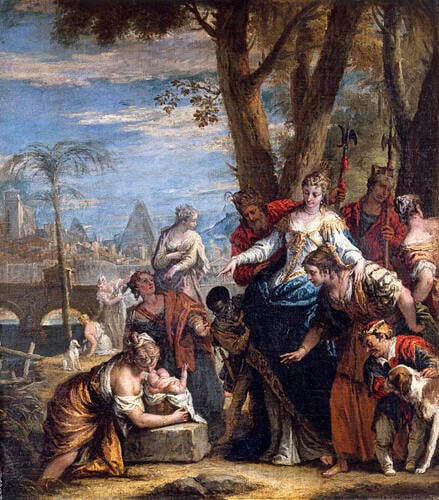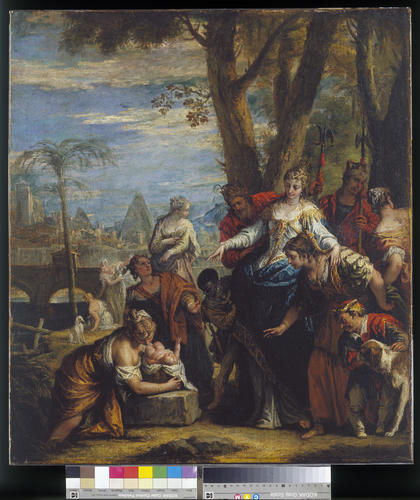-
1 of 253523 objects
The Finding of Moses c.1720-25
Oil on canvas | 71.5 x 62.7 cm (support, canvas/panel/stretcher external) | RCIN 404764
-
The sumptuously dressed daughter of the Pharoah with her attendants has discovered Moses in a basket of rushes, cradled by his sister Miriam, and takes pity on him. The account in Exodus (2: 1–10) describes how Miriam offers to find a Hebrew woman to nurse Moses, and his own mother is then called upon.
Sebastiano's painting, jewel-like in rich colours, seems to have been inspired by Veronese's small version of the subject of c.1580 (Museo Nacional del Prado, Madrid). In the 'Italian List' Sebastiano's version is listed as by Veronese. John Baptist Jackson subsequently reproduced it in his series of 17 reproductions in chiaroscuro woodcut of works by great Venetian artists (see RCIN 830897 and RCIN 831198), inscribing the print as being after a Veronese in Consul Smith's collection. But Smith must have known that the work was not by the sixteenth-century master and it has been suggested that he commissioned the Jackson print in a 'resounding deception' on George III.
However, Sebastiano may have been referring back to a now lost version of the subject by Veronese in Smith's collection, and it was that work that was reproduced by Jackson. Veronese included the distinctive pointing gesture of Pharoah's daughter in a study for this lost version (Pierpont Morgan Library, New York), which was also copied by Pietro Liberi (1605–87) for his painting of the 1670s (private collection). This is supported by the fact that Jackson tended to reproduce the original paintings with very few changes, while there are differences between the Ricci painting and the print: the print is taller than the painting, including the foliage of the trees above, and the group of figures is set further back in the scene. It is more likely that Smith did not include the Veronese Finding of Moses in the part of his collection he sold to George III in 1762 and instead sold it separately. He may have commissioned Sebastiano to paint the copy, since Veronese was so important to both artist and patron – Sebastiano made at least nine copies of works by Veronese for Smith.
While close to Veronese's version, Sebastiano's painting is distinctively eighteenth-century in style and technique. Both artists painted with great fluency but Sebastiano's figures are more elegant, his colours, particularly the reds and blues, more vivid, and the overall effect is more sumptuous, lighter and more ebullient – as Blunt wrote, 'in an idiom which owes more to the painting of the early French rococo than to anything in Italian art'.
Text adapted from Canaletto & the Art of Venice, 2017.Provenance
Acquired in 1762 by George III from Joseph Smith, British Consul in Venice, as a Veronese (Italian List no 209 as Veronese); recorded in the Queen's Drawing Room at Kew in 1805 as Bassano (no 20) and here again in 1828 as Sebastiano Ricci (no 1157)
-
Creator(s)
Acquirer(s)
-
Medium and techniques
Oil on canvas
Measurements
71.5 x 62.7 cm (support, canvas/panel/stretcher external)
86.4 x 77.9 x 5.0 cm (frame, external)
Category
Object type(s)

